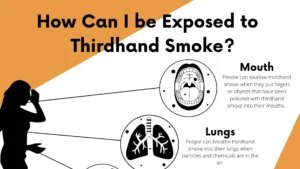Everything to Know about Thirdhand Smoke
Introduction:
While most people are aware of the dangers of secondhand smoke, a lesser-known threat comes in the form of thirdhand smoke. Thirdhand smoke refers to the residual toxic chemicals left behind on surfaces and in dust particles after smoking has occurred. Although the concept may sound relatively harmless, research has shown that thirdhand smoke can pose serious health risks, especially for vulnerable individuals such as children and nonsmokers living in environments exposed to frequent smoking. In this article, we will delve into what thirdhand smoke is, its health effects, prevention methods, and when it becomes necessary to seek medical help.

What is it?
Thirdhand smoke is the residue that lingers on surfaces, furniture, clothing, and other objects after someone has smoked in an area. The chemicals found in cigarette smoke, such as nicotine, lead, formaldehyde, and benzene, can stick to these surfaces and remain present for weeks or even months. Even though the smoke dissipates, the harmful chemicals remain and can later re-enter the air as dust particles or be ingested or absorbed through the skin by individuals in the vicinity. This means that even places where smoking is not currently taking place can still harbor the dangers of thirdhand smoke.
Health Effects:
The health effects of thirdhand smoke can be far-reaching and concerning. Studies have linked exposure to thirdhand smoke with an increased risk of respiratory issues, such as asthma and bronchitis, as well as an elevated chance of developing allergies and certain types of cancers. Infants and young children are particularly vulnerable since they frequently come into contact with contaminated surfaces and put objects in their mouths. The residual chemicals in thirdhand smoke have also been shown to have negative effects on liver function and can potentially cause DNA damage. It is important to understand that even small amounts of exposure to thirdhand smoke can have long-lasting health consequences.
Prevention:
Taking steps to prevent thirdhand smoke exposure is crucial, especially in homes, vehicles, or public areas where smoking occurs or has occurred. Here are some preventive measures to consider:
- Implement a strict no-smoking policy inside homes or vehicles to reduce the build-up of thirdhand smoke residue.
- Wash clothing, bedding, and curtains regularly to remove any residual chemicals.
- Clean and vacuum surfaces frequently to eliminate dust particles that may contain toxic residues.
- Ensure proper ventilation in smoking areas to minimize the accumulation of smoke chemicals on surfaces.
When to Seek Doctor Help:
If you suspect that you or someone you know has been exposed to thirdhand smoke and are experiencing any concerning symptoms or health issues, it is crucial to seek medical help. Symptoms might include persistent cough, difficulty breathing, skin rashes, or allergic reactions. Additionally, it is important to have infants and young children regularly evaluated by pediatricians to monitor any potential effects of thirdhand smoke exposure. Medical professionals can provide appropriate guidance, perform necessary tests, and recommend appropriate treatment if needed.
Summary:
Thirdhand smoke poses a significant but often overlooked health risk. The lingering residue from cigarette smoke can contain hazardous chemicals that remain on surfaces and re-enter the air as dust particles. This can lead to various health problems, particularly respiratory issues and an increased risk of developing allergies and cancers. Preventive measures such as implementing no-smoking policies, regular cleaning, and proper ventilation are crucial for minimizing thirdhand smoke exposure. If concerned about potential exposure or experiencing related symptoms, seeking medical help is essential for proper evaluation and guidance. By understanding and taking steps to mitigate the risks of thirdhand smoke, we can create healthier environments for ourselves and those around us.